
Training
Surya Fire Service Provides Fire Fighting class with Demonstration. In this section an interesting article about fire is provided in the interest of public fire safety. Here you can learn about Fire, Fire Prevention, Fire Safety and Fire Drill. For fire classes and demonstration please contact us.
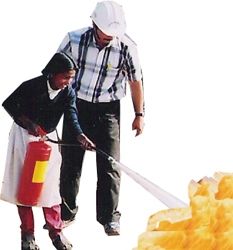 |
|
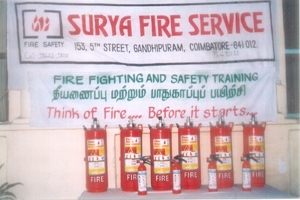 |
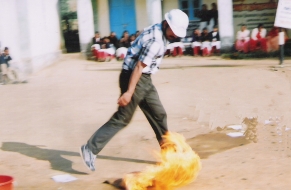 |
|
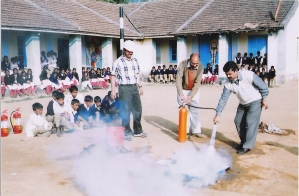 |
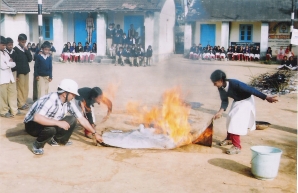 |
|
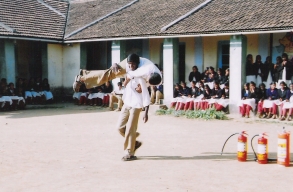 |
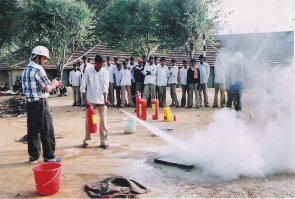 |
|
Fire.
The earliest use people made of fire was to keep warm. As civilizations advanced, people learned to use fire in many other ways. People learned to use fire to cook food, to shape weapons and tools, to change clay into pottery, and to furnish light. But early peoples had extremely slow and unsatisfactory ways of kindling fires. Today, we have not only improved the methods of kindling fires, but we also use fire in many more ways. Fire furnishes the energy to drive machines, and keeps industries running. It supplies the power to drive trains, ships, and planes; and it generates electricity. Fire is also used to remove and destroy waste materials. In addition, fire is used in separating most metals from their ores, as well as in forging and shaping metals into useful things.
Controlled fire is useful. But fire can also be destructive. Uncontrolled fire kills thousands of people and destroys Crores of rupees worth of property each year. Fires burned down large parts of London in 1666, Chicago in 1871, and Tokyo in 1923. Fires also destroy large areas of trees and brush every year.
What is Fire?
Fire is the heat and light that comes from burning substances. In 1777, Antoine Lavoisier, a French chemist, proved that burning is the result of the rapid union of oxygen with other substances As a substance burns, heat and light are produced. Burning is also called combustion. Often oxygen unites with other substances at such a slow rate that little heat and no light are given off. When this happens, we call the process oxidation, rather than burning or combustion. Oxidation takes place whenever oxygen unites with other substances either rapidly or slowly. For example, when oxygen unites with gasoline, the action takes place rapidly and heat and light are given off. This process may be described by any of the three words, burning, combustion, or oxidation. When oxygen unites with iron and causes it to rust, burning, or combustion, does not take place, but oxidation does.
Kinds of Fire.
All substances do not burn in the same manner. Charcoal, for example, gives off heat with a faint glow. But other substances, such as coal, gas, magnesium, oil, and wood, give off heat with a flame. The color of the flame depends chiefly on the kind of material being burned and on the temperature.
Substances may burn in different ways, but they all require oxygen to burn. Sometimes old rags soaked with oil or paint are thrown aside and forgotten. Oxygen from the air may slowly unite with the oil in the rags. At first, there will not be a fire. But as oxidation gradually takes place, enough heat accumulates to set the rags on fire. This type of burning, called spontaneous combustion, causes many fires.
Very rapid burning may cause explosions like those produced by gunpowder and dynamite. Here, oxidation takes place so rapidly that great volumes of gases are produced. These require many hundreds of times the space that was formerly occupied by the gunpowder or dynamite before it was oxidized. These gases expand so rapidly and violently that they produce an explosion.
How Fire is Produced.
Three conditions must exist before a fire can be made. There must be a fuel or a substance that will burn. The fuel must be heated to its ignition temperature. This is the lowest temperature at which combustion can begin and continue. Finally, there must be plenty of oxygen, which usually comes from the surrounding air.
Fuels are of three classes, solids, liquids, and gases. Coal and wood are examples of solids. Oil and gasoline are liquid fuels. Natural gas and hydrogen are gaseous fuels.
The burning of a solid fuel often depends on the form of the fuel. The ignition temperatures of fuels differ. For a solid or liquid fuel to ignite, some of the fuel must first be heated to the temperature at which it vaporizes (turns to a gas). Solids generally have higher ignition temperatures than liquids because they vaporize at higher temperatures. For example, the ignition temperatures of most woods and plastics range from about 500 to 900 °F (260 to 480 °C). A liquid fuel such as gasoline can ignite at a temperature as low as -36 °F (-38 °C).
Electrical fire is another danger. When an electric current passes through a conductor, resistance causes the conductor to become hot. Sometimes the heat is desirable. For example, the wires in a toaster heat up to brown bread. But overheating in electrical cords or in household wiring can cause a fire. Electrical fires destroy many homes every year. To avoid fires, do not plug too many devices into the same outlet, and never use electric devices with worn or frayed cords.
In addition, every fuel has two ignition temperatures. At one temperature, combustion can occur with the help of an outside energy source, such as a match. At another, higher temperature, combustion can occur spontaneously-that is, without outside help.
How Fire Behave?
A candle burning in a room without drafts produces a steady flame. The flame's heat vaporizes just enough candle wax to keep the flame burning at the same height.
Uncontrolled fires, on the other hand, fuel themselves by vaporizing the solid or liquid materials they find in their path. A house fire or forest fire may begin with easily ignitible materials. As the fire grows, it radiates more heat. The heat contributes to further growth, and the process accelerates as long as fuel and oxygen remain available.
In a house fire, a phenomenon known as flashover occurs when all the surfaces in a room reach their ignition temperature. At this point, a relatively small fire suddenly ignites the remaining materials, filling the room with flames. In a forest fire, leaves, twigs, and other materials along the ground usually make up the fuel. But wind and certain types of terrain may cause a forest fire to spread along the tops of trees. Because fires can grow quickly and suddenly, professional fire fighters should immediately be called to control them.
We can control the fire in a furnace by regulating the supply of fuel and oxygen it receives. But only winds and the flow of air created by the fire regulate the rate of burning of an uncontrolled fire.
Fireproof materials. The term fireproof suggests that a material has been treated with a substance that will prevent it from burning. But no material is truly fireproof. Even such incombustible materials as concrete and stone can become damaged by an intense fire.
Materials can, however, be treated with a fire retardant to reduce their ability to burn. Most fire retardants act to raise the ignition temperature of a material or to reduce the heat produced by combustion. Such treatments can slow combustion but they do not eliminate it.
What Fire Produces ?
An entire piece of wood or coal will not burn, even if there is sufficient oxygen present. Most of us have taken the ashes from a charcoal grill or fireplace. The ash, generally a mixture of minerals, is present in the fuel, but will not unite with the oxygen. Some fuels have a lower ash content than others. This is important to remember when buying charcoal or wood because you want the fuel with the lowest ash content, provided that it is good in other respects.
Often the bottom of a pan or a skillet becomes black when it is placed over a fire. This discoloration occurs because of soot. Soot is primarily unburned carbon. The skillet becomes coated because it cools the flame, preventing the temperature from getting high enough to burn the fuel completely. If a furnace produces great quantities of soot, some of the carbon of the fuel is not being burned, and is wasted. This problem can be remedied by seeing that sufficient air is supplied to burn all the carbon in the fuel.
Gases. Substances that burn in air are nearly always composed of two elements, carbon and hydrogen, or their compounds. For example, coal, coke, and charcoal are mostly carbon. Natural gas, gasoline, and fuel oils consist of many compounds of hydrogen and carbon. When these fuels burn, the oxygen of the air unites with the carbon and hydrogen to form carbon dioxide gas and water vapor. These usually mix with the air and disappear. The uniting of the oxygen with the hydrogen and the carbon is what produces the heat and flame of the fire.
Often, a deadly gas called carbon monoxide forms when there is not enough oxygen to burn the fuel completely. For example, when gasoline burns in an automobile engine, some of this gas forms and comes out the exhaust pipe. If you are in a closed garage when this happens, you are in danger of breathing this gas. Death may result. A person should never run the engine of an automobile in a closed garage.
Most people who are killed in fires in buildings die from inhaling carbon monoxide. Both smoldering fires and too little oxygen following flashover can promote the production of this gas.
Smoke is a mixture of soot and other particles with the gases produced by combustion. Smoke from fires can contain carbon monoxide and other poisonous gases. The soot and particles hamper vision and thus can make it difficult to escape from fires. In general, smoke results from incomplete combustion, which wastes energy and pollutes the environment.
Light. Most of the energy caused by a fire goes into heat, but some of it goes into light. The light results either because the carbon particles in the flame become so hot that they give off light energy, or because the gas that is burning is a type that gives off light.
Fire Prevention And Fire Safety.
To help prevent fires and reduce fire losses, local fire departments inspect public buildings. They also teach people about fire safety. Many fire departments have a separate division that handles fire prevention and fire safety programs.
Public building inspections. Most cities have a fire safety code that applies to such buildings as theaters, department stores, schools, and hospitals. These codes specify that the buildings should not be made of materials that burn easily. The codes also require portable fire extinguishers, a certain number of exits, and other fire safety features in public buildings.
Many fire safety codes require large buildings to have built-in sprinkler systems and special water lines to which fire hoses can be attached. A sprinkler system consists of a network of pipes that is installed throughout a building. The pipes carry water to nozzles in the ceiling. The heat from a fire causes the nozzles directly above the fire to open and spray water. The sprinklers put out or control most fires before the fire department arrives. Many fire safety codes also require high-rise structures to have fire alarm systems.
Fire department officials inspect public buildings to enforce the local code. The officials check the operating condition of the fire protection systems. They note the number and location of exits and fire extinguishers. The inspection also covers housekeeping practices and many other matters that affect fire safety. Fire department inspectors may also review plans for a new building to make sure it meets the safety code.
Public education programs. Many fire departments work with other local agencies to teach people how to prevent fires and what to do during a fire. Many home fires are caused by leaving the kitchen when food is cooking, disposing of cigarettes improperly, misusing portable heating equipment, and placing flammable or combustible items too close to heat sources. To make your home safer, check the heating and air-conditioning systems and the cooking equipment. Look for unsafe practices, such as overloading electric outlets or running electric cords under a rug. It is important to know what to do if a fire breaks out. To leave the home safely and quickly in case of fire, families are advised to make escape plans and to practice fire drills.
Fire departments advise people to install smoke detectors in their homes. Smoke detectors are devices that sound an alarm if a small amount of smoke enters their sensors. Smoke detectors are attached to the ceiling or wall in several areas of the home. Fire protection experts recommend at least one detector for each floor of a residence. Most home fires that result in deaths occur at night when the family is asleep. Smoke detectors will awaken the family before the flames and the smoke build up to the point where escape is impossible.
Fire departments also recommend that people have portable fire extinguishers in their homes. A person must be sure, however, to call the fire department before trying to extinguish a fire. It is also important to use the right kind of extinguisher for the type of fire involved. For example, a water extinguisher cannot put out a grease fire. Such a fire can be fought with a special extinguisher.
Fire Extinguisher
Fire extinguisher is a metal container filled with water or chemicals used to put out fires. Fire extinguishers are portable and easy to operate and can be used to put out small fires before the flames spread. The extinguishers are to be installed in easily seen places in public buildings. Such buildings include factories, schools, stores, and theaters. School buses, boats, and most public vehicles also must have extinguishers.
Kinds of Fire Extinguishers.
There are many kinds of fire extinguishers. The kind used depends on the type of fire involved. Fire prevention experts divide fires into four classes - A, B, C, and D-depending on the burning material.
Class A fires involve such materials as cloth, paper, rubber, or wood.
Class B fires involve flammable gases or such flammable liquids as cooking grease, gasoline, or oil.
Class C fires involve motors, switches, or other electrical equipment through which electric current is flowing.Class D fires involve combustible metals, such as magnesium chips or shavings. Most extinguishers are labeled with the class, or classes, of fire for which they can be used. Class D fires require special extinguishers designed for specific metals.
Most fire extinguishers can be classified, by their contents, as one of four types: (1) water, (2) foam, (3) liquefied gas, and (4) dry chemical.
Water extinguishers are used to fight only class A fires. Water conducts electric current, and so it must never be used on a fire involving electrical equipment. A water extinguisher is operated by a lever or a hand pump that shoots the water through an attached hose.
Foam extinguishers are used for class A and class B fires. They contain water and a foaming agent. One type of foam puts out fires that involve combustible liquids by depositing a film between the liquid and the flame.
Dry chemical extinguishers are used on class B and C fires. One type, the multipurpose dry chemical extinguisher, also can be used against class A fires. A stored pressure dry chemical extinguisher has a cylinder containing a chemical powder and a gas under pressure. Another type of dry chemical extinguisher stores the gas in a cylinder or cartridge separate from the powder. Before using it, users must enable the gas to flow into the main compartment by turning a valve or operating a lever that punctures the gas compartment.
Fire Drill
Fire drill is an exercise to teach people to leave a place safely and speedily if fire breaks out. Without the practice a fire drill provides, people may become frightened and confused when they have to leave a burning area. Fire drills are important exercises at home, work, and school. In public buildings and many businesses, signs tell people the escape routes for the building. Fire drills are also practiced on ships and at such places as airports and oil refineries.
Many states have laws that require regular school fire drills. In most schools, each classroom has directional signs. Signs and red lights in halls show the nearest exit for children who are not in a classroom when the fire bell rings. When the alarm is given, the teacher sees that the class leaves the school in a quiet, orderly manner.
Home | Sitemap | Contact us
Surya Fire Service, Coimbatore, Tamilnadu, India